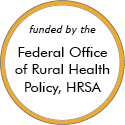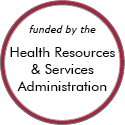Rural Project Examples: Effective
Browse rural projects that meet this collection's second highest level of evidence. For each example listed, the approach has been reported in a peer-reviewed publication.
Farm Dinner Theater
Updated/reviewed November 2025
- Need: To encourage farmers to make health and safety changes on their farms.
- Intervention: Farm Dinner Theater is an event in which farmers and their families watch three 10-minute plays covering health and safety topics and then discuss solutions to the issues addressed in each.
- Results: In a study, farmers who attended the plays were more likely to make changes and tell others what they learned, compared to farmers who received an educational packet with the same information.
Health Coaches for Hypertension Control

Updated/reviewed November 2025
- Need: A cost-effective approach to help rural patients with hypertension learn to manage their condition.
- Intervention: Community volunteers trained as health coaches provided an 8-session hypertension management training program to hypertension patients older than 60, with an optional supplemental 8 sessions focused on nutrition and physical activity.
- Results: Just 16 weeks after the program, participants had improved systolic blood pressure, weight, and fasting glucose, greater knowledge of hypertension, and improved self-reported behaviors.
Vermont Hub-and-Spoke Model of Care for Opioid Use Disorder
Updated/reviewed November 2025
- Need: In the early 2010s, needed increase access to medication treatment for opioid use disorder in rural Vermont.
- Intervention: 2012-2016 implementation of a statewide hub-and-spoke treatment access system.
- Results: The original system's increased treatment capacity and care coordination successes now are a permanent system of integrated care overseen by the Vermont state health department and Vermont Blueprint for Health.
Kentucky Homeplace
Updated/reviewed October 2025
- Need: Rural Appalachian Kentucky residents have deficits in health resources and health status, including high levels of cancer, heart disease, hypertension, asthma, and diabetes.
- Intervention: Kentucky Homeplace was created as a community health worker initiative to provide health coaching, increased access to health screenings, and other services.
- Results: From July 2001 to June 2025, over 202,000 rural residents were served. Preventive health strategies, screenings, educational services, and referrals are all offered at no charge to clients.
The Pacific Care Model: Charting the Course for Non-communicable Disease Prevention and Management
Updated/reviewed October 2025
- Need: The U.S. Associated Pacific Islands (USAPI) needed an efficient, effective, integrated method to improve primary care services that addressed the increased rates of non-communicable disease (NCD), the regional-specific phrase designating chronic disease.
- Intervention: Through specialized training, multidisciplinary teams from five of the region's health systems implemented the Chronic Care Model (CCM), an approach that targets healthcare system improvements, uses information technology, incorporates evidence-based disease management, and includes self-management support strengthened by community resources.
- Results: Aimed at diabetes management, teams developed a regional, culturally-relevant Non-Communicable Disease Collaborative Initiative that addresses chronic disease management challenges and strengthens healthcare quality and outcomes.
Meadows Diabetes Education Program

Updated/reviewed September 2025
- Need: To provide diabetes care and education services to those in rural southeast Georgia.
- Intervention: Diabetes outreach screening, education, and clinical care services were provided to participants in Toombs, Tattnall, and Montgomery counties. The program is no longer active.
- Results: Patients successfully learned self-management skills to lower their blood sugar, cholesterol, and blood pressure.
New Mexico Mobile Screening Program for Miners


Updated/reviewed April 2025
- Need: To increase access to medical screening for miners in New Mexico.
- Intervention: A mobile screening clinic with telemedicine capability screens miners for respiratory and other conditions.
- Results: In a survey, 92% of miners reported their care as very good, while the other 8% reported it as good. The program has expanded to three other states.
Parent Partners
Updated/reviewed April 2025
- Need: To support parents whose children have been removed from the home so that the parents can make the changes needed for the children to return safely home.
- Intervention: A statewide program in Iowa pairs these parents with mentors who have successfully navigated their own child welfare cases.
- Results: Participants' children were more likely to return home than non-participants' children, and participants were less likely to have another child removal within a year of the child coming home.
Wyoming Trauma Telehealth Treatment Clinic
Updated/reviewed April 2025
- Need: To provide psychotherapy to survivors of domestic violence and sexual assault.
- Intervention: University of Wyoming psychology doctoral students provide psychotherapy via videoconferencing to crisis center clients in two rural locations.
- Results: Clients, student therapists, and crisis center staff were satisfied with the quality of services, and clients reported reduced symptoms of depression and PTSD.
Franklin Cardiovascular Health Program (FCHP)
Updated/reviewed March 2025
- Need: To develop sustainable, community-wide prevention methods for cardiovascular diseases in order to change behaviors and healthcare outcomes in rural Maine.
- Intervention: Local community groups and Franklin Memorial Hospital staff studied mortality and hospitalization rates for 40 years in this rural, low-income area of Farmington to seek intervention methods that could address cardiovascular diseases.
- Results: A decline in cardiovascular-related mortality rates and improved prevention methods for hypertension, high cholesterol, and smoking.
